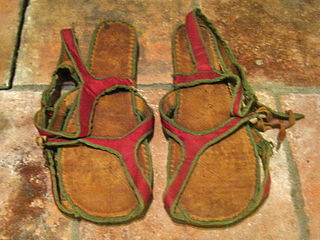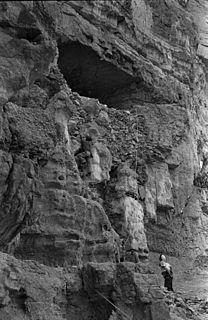Preface

Coiled sewn sandals are an ancient Egyptian footwear constructed using a technique similar basket weaving whereby coils were sewn together with the same material used in construction of the coils.

Coiled sewn sandals are an ancient Egyptian footwear constructed using a technique similar basket weaving whereby coils were sewn together with the same material used in construction of the coils.
The first evidence of coiled fabric was found in an expedition of Mersa/Wadi Gawasis in 2005-2006, which led to the discovery of artifacts, including the fabric. [1] These expeditions began in 2001, and the coiled fabric found within caves at the site were a large part of the discovery. [2] Coil sewn sandals in ancient Egypt were a Middle Kingdom creation. [1] This is evidenced through reliefs within the period displaying that particular shape of sandal. [1] The cave that specifically featured the rope coils was Cave 5. [2] Scholars have since studied the coils with the purpose of identifying their construction process and proposed purpose. [2]
The soles of the sandals were made of coiled halfa grass that was sewn together with strips of dom palm leaf, that helped to mat the grass together. [1] The coiling process would begin where bundles of the rope would be folded around themselves, providing both shape and a strong edge. [1] After each layer of coil was laid, it would be stitched to the previous coil, which would continue until the desired sandal design was obtained. [1] Though the styles of these sandals varied within the Middle Kingdom, the techniques remained mostly the same, and followed the pattern of being longitudinally symmetrical with a slightly taken-in middle. [1] Coil sewn sandals also featured two distinct types of straps. [1] The first was similar to that of regular sewn sandals where the front strap is made of a large strip of papyrus that is placed between the coils at the front and secured with a knot in the back. [1] The second is a folded strap that loops around the back. [1] Both are placed in-between the second and third bundle rather than being attached to the outside of the sandal. [1] Either of the strap complexes, as well as the shape of the sandals, gives the footwear a distinct sturdiness at the heel and strap region. [1]
The discovery of the Cave 5 and the contents therein lead to an investigation on the materials used for rope, coils, and other plant-based inventions. [2] Materials like papyrus, halfa grass, and palm leaf were used for a variety of building and construction materials in Ancient Egypt. [2] This is significant because each material directly correlates to a myriad of construction methods within Ancient Egypt. [2] They also relate to the locality of objects such as shelters, roofs, mats, and sewing materials mentioned previously. [2] This is helpful to determine further how various objects like the coil sewn sandals were made, how they were made, and where they were primarily utilized. [2]

Papyrus is a material similar to thick paper that was used in ancient times as a writing surface. It was made from the pith of the papyrus plant, Cyperus papyrus, a wetland sedge. Papyrus can also refer to a document written on sheets of such material, joined together side by side and rolled up into a scroll, an early form of a book.

A shoe is an item of footwear intended to protect and comfort the human foot. Shoes are also used as an item of decoration and fashion. The design of shoes has varied enormously through time and from culture to culture, with appearance originally being tied to function. Additionally, fashion has often dictated many design elements, such as whether shoes have very high heels or flat ones. Contemporary footwear in the 2010s varies widely in style, complexity and cost. Basic sandals may consist of only a thin sole and simple strap and be sold for a low cost. High fashion shoes made by famous designers may be made of expensive materials, use complex construction and sell for hundreds or even thousands of dollars a pair. Some shoes are designed for specific purposes, such as boots designed specifically for mountaineering or skiing.

Amenemhat III, also spelled Amenemhet III, was a pharaoh of the Twelfth Dynasty of Egypt. He ruled from c. 1860 BC to c. 1814 BC, the highest known date being found in a papyrus dated to Regnal Year 46, I Akhet 22 of his rule. His reign is regarded as the golden age of the Middle Kingdom. He may have had a long coregency with his father, Senusret III.

A rope is a group of yarns, plies, fibers or strands that are twisted or braided together into a larger and stronger form. Ropes have tensile strength and so can be used for dragging and lifting. Rope is thicker and stronger than similarly constructed cord, string, and twine.

Flip-flops are a type of sandal, typically worn as a form of casual wear. They consist of a flat sole held loosely on the foot by a Y-shaped strap known as a toe thong that passes between the first and second toes and around both sides of the foot or can be a hard base with a strap across all the toes.

Zōri (草履) are flat and thonged Japanese sandals made of rice straw, cloth, lacquered wood, leather, rubber, or — most commonly and informally — synthetic materials.

Sandals are an open type of footwear, consisting of a sole held to the wearer's foot by straps going over the instep and around the ankle. Sandals can also have a heel. While the distinction between sandals and other types of footwear can sometimes be blurry, the common understanding is that a sandal leaves all or most of the foot exposed. People may choose to wear sandals for several reasons, among them comfort in warm weather, economy, and as a fashion choice.

Shoemaking is the process of making footwear.

Wādī Ḥalfā is a city in the Northern state of Sudan on the shores of "Lake Nubia" near the border with Egypt. It is the terminus of a rail line from Khartoum and the point where goods are transferred from rail to ferries going down the lake. As of 2007, the city had a population of 15,725. The town is located amidst numerous ancient Nubian antiquities and was the focus of much archaeological work by teams seeking to save artifacts from the flooding caused by the completion of the Aswan Dam.

Episcopal sandals, also known as the pontifical sandals, are a Roman Catholic pontifical vestment worn by bishops when celebrating liturgical functions according to the pre–Vatican II rubrics, for example a Tridentine Solemn Pontifical Mass.

Byzantine emperors dress changed considerably over the thousand years of the Empire, but was essentially conservative. The Byzantines liked colour and pattern, and made and exported very richly patterned cloth, especially Byzantine silk, woven and embroidered for the upper classes, and resist-dyed and printed for the lower. A different border or trimming round the edges was very common, and many single stripes down the body or around the upper arm are seen, often denoting class or rank. Taste for the middle and upper classes followed the latest fashions at the Imperial Court. As in the West during the Middle Ages, clothing was very expensive for the poor, who probably wore the same well-worn clothes nearly all the time; this meant in particular that any costume owned by most women needed it to fit throughout the full term of a pregnancy.

Spanning over two thousand years, ancient Egypt was not one stable civilization but in constant change and upheaval, commonly split into periods by historians. Likewise, ancient Egyptian architecture is not one style, but a set of styles differing over time but with some commonalities.

A dress shoe is a shoe to be worn at smart casual or more formal events. A dress shoe is typically contrasted to an athletic shoe.

The preservation of fabric fibers and leathers allows for insights into the attire of ancient societies. The clothing used in the ancient world reflects the technologies that these peoples mastered. In many cultures, clothing indicated the social status of various members of society.

The Cave of Letters is a cave in Nahal Hever in the Judean Desert where letters and fragments of papyri from the Roman Empire period were found. Some are related to the Bar Kokhba revolt, including letters of correspondence between Bar-Kokhba and his subordinates. Another notable bundle of papyri, known as the Babatha cache, comprises legal documents of Babatha, a female landowner of the same period.

Abu Simbel is a village in the Egyptian part of Nubia, about 240 km (150 mi) southwest of Aswan and near the border with Sudan. As of 2012, it has about 2600 inhabitants. It is best known as the site of the Abu Simbel temples, which were built by King Ramses II.

Ancient Egyptian clothes refers to clothing worn in ancient Egypt from the end of the Neolithic period to the collapse of the Ptolemaic Kingdom with the death of Cleopatra in 30 BC. Egyptian clothing was filled with a variety of colors. Adorned with precious gems and jewels, the fashions of the ancient Egyptians were made for not only beauty but also comfort. Egyptian fashion was created to keep cool while in the hot desert.

Several ancient Egyptian solar ships and boat pits were found in many ancient Egyptian sites. The most famous is the Khufu ship now preserved in the Giza Solar boat museum beside the Great pyramid at Giza. The full-sized ships or boats were buried near ancient Egyptian pyramids or temples at many sites. The history and function of the ships are not precisely known. They might be of the type known as a "solar barge", a ritual vessel to carry the resurrected king with the sun god Ra across the heavens. However, some ships bear signs of being used in water, and it is possible that these ships were funerary barges.

Wadi al-Jarf is the present name for an area on the Red Sea coast of Egypt, 119 km (74 mi) south of Suez, that is the site of the oldest known artificial harbour in the world, developed about 4500 years ago. It is located at the mouth of the Wadi Araba, a major communication corridor between the Nile Valley and the Red Sea, crossing the Eastern Desert. The site is across the Gulf of Suez from the small Sinai fortress of Tell Ras Budran. A somewhat similar ancient port is at Ain Sukhna, a little north of Wadi al-Jarf.
Upanah (Sanskrit) is an ancient form of footwear from India. The term is used to refer to several types of strapped sandals and shoes emploed by common people, in contrast to monks and mendicants who would use paduka instead. The word comes from the Sansakrit root nah, meaning "to tie", "to bind", to "fasten", as well as pad, meaning "foot". Combinated words like charan-upanah might have originated modern words like "chappal".
| This article about Egyptology or subjects relating to Ancient Egypt is a stub. You can help Wikipedia by expanding it. |